Scratch Blast! Original Design / Scratch Built
Scratch - Blast! {Scratch}
Contributed by Todd Mullin
| Manufacturer: | Scratch |
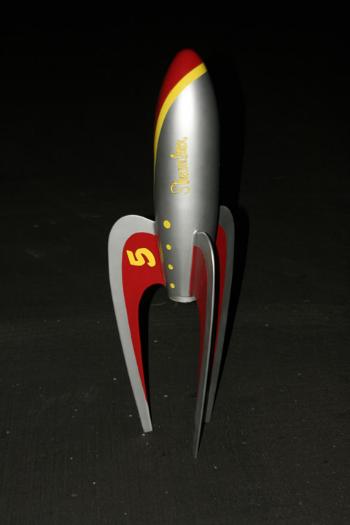
This is the story of two different rockets that are the same. That may sound contradictory, but let me explain.
About a year ago, I got a sneak peak at the 2007 EMRR Challenge, including the Design This Rocket portion of the contest. I had suggested after the 2006 contest that more 1950’s "retro" style rockets might make a cool contest, so I was greatly pleased to see that that was the theme! I laid out my strategy for completing my entry for the contest, but little did I know that the rocket was going to fight back! With the prize for the contest being a statue of the winning rocket entry, I chose the rocket design that I liked best, not necessarily the one that was worth the most possible points!
My model of CoolRockets.com’s Blast! was originally designed around Estes BT-80 tubing. I intended to use the nosecone recycled from a crashed Estes Fatboy. For the fins, I was thinking basswood more than balsa due to the extreme sweep. I really liked the nice clean lines of the Blast! with the seamless nose, which lead me to the decision to have my model rear eject so that I could eliminate the nosecone seam as well.
The picture of the Blast posted on the EMRR contest page was at a fairly dramatic angle, so I knew that the fin pattern would be fairly foreshortened and not entirely accurate to trace. After a bit of scrounging on CoolRockets.com, I found a picture of the Blast! in profile, which I downloaded. Even though the photo was very small and only web quality, I was able to get a fairly good tracing in AutoCAD of the fins and body shape.
To kill two birds with one stone, I documented the process that I was going to use to taper the body tube into the nice, curved shape of the Blast! for my EMRR Featured Tip (../../featured/tip_featured14.shtml)! This method was developed by Korey Kline and was documented in a US Rockets pamphlet that I received with one of their kits.
After working out the pattern in AutoCAD, I printed the wrap and carefully traced it onto the BT-80 body tube. I cut the pie shapes out with scissors and an x-acto knife. Then I glued a section of BT-60 tube into the BT-80 with a centering ring. The BT-60 was going to act as the stuffer tube that my motor mount would slide into. I gently bent the "fingers" of BT-80 tubing in and super glued them to the BT-60 and sealed the seams between each as well. After a bit of sanding, I produced a fairly smooth curve to the tail cone. I then cut thru-the-wall slots in the tail cone so that the super swept fins could anchor solidly to the stuffer tube as well as to the tail cone.
The fins for the original design were to be built up from three layers to duplicate the slightly raised sections that are visible on close inspection of the original design. I cut out my paper patterns and spray glued them to the basswood. I used 1/8" for the center and 1/16" for the outer layers. I intended to keep the pattern on the wood to eliminate the need to fill the grain. I found this technique worked fairly well. After coating the paper laminate with a thin layer of superglue to reduce the "fuzzies" that are produced by sanding paper, I was able to achieve a nice finished, double thick fin, which I carefully adhered to the tail.
Another feature that I incorporated into my original design was an internal launch lug. I didn’t want a big, clunky lug marring the look of the teardrop body. In assembling my motor mount, I glue my lug to the motor tube and cut holes in the centering rings thus allowing the launch rod to pass through it. I then put the mount into the tail with the nosecone in place and slid a launch rod in with a small dab of paint on it’s end. Having already cut the base from the nosecone, the rod slid up and clearly marked the inside with the paint where I needed to drill a hole to allow it to exit the front of the rocket.
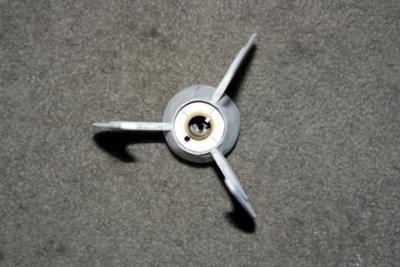
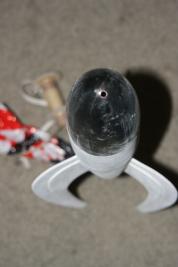
After drilling the launch rod exit, the rocket was essentially complete! The shock cord and parachute were tied in and Blast! was ready to fly. Rocksim said that the design was unstable, but it doesn’t deal well with short stubby rockets. A quick swing test confirmed Rocksim’s opinion… Nose weight would be needed. A couple of fishing sinkers later, the model was swinging perfectly!
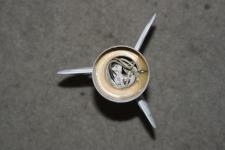
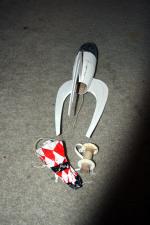
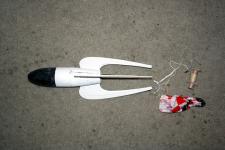
Being a bit superstitious with my rockets, I chose to fly Blast! nekkid for it’s maiden flight. Pretty rockets don’t stay pretty long…
I was very excited to make the first flight of my new creation. I was really proud of the internal lug design (which really was pretty spiffy…) I loaded up a C6-3 and loaded Blast! onto the pad. After calling a heads up, I hit the launch button. The rocket shot off the pad quickly, but after the initial thrust spike, there was not enough impulse to maintain it’s trajectory. Blast! arched over sharply and cruise-missiled into the sand behind the flight line without ejecting. As I was running over to retrieve it, the ejection charge popped. The motor mount must have become lodged from the impact, as the nosecone ejected and the body tube ruptured and actually caught fire. This is the first time that I’ve actually had a rocket catch fire… Not an auspicious first flight for my triumphant design…
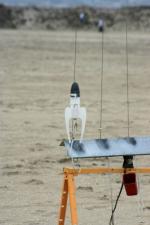
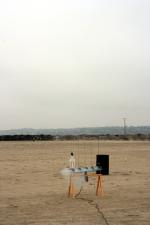
I returned to my workbench to repair my poor little burned up rocket. Luckily, the tail cone and fins had survived the crash intact. I spliced in a new, slightly longer section of body tube and replaced the charred elastic shock cord with one made of braided 150 test fishing line. The repair was not pretty, but I wanted proof of concept before I took the time to make it as pretty as it deserved to be.
I returned to the DART launch field the next month to the mocking of my fellow club members who had witnessed the first flight. Oh, well… I probably would have done the same had their rockets had the same flight!
Knowing that the C6-3 didn’t have enough impulse for a safe flight, I loaded up my trusty 18mm Aerotech case with a D13-4 reload. Again, a quick swing test showed that the model should be stable in flight. Off to the pads once more. After a couple of misfires (gotta love Copperheads), Blast! leapt off the pad and wiggled it’s way into the sky. Maybe a little more nose weight to straighten it out on the next flight I thought. It arched over and was headed down, which was the planned flight profile, when the ejection charged fired extremely energetically. The shock cord snapped after being strained too far and the parachute stripped. The model again crashed into the sand of the flying field, this time hard enough to crush the nose cone, tear the body tubing and crunch one of the fins. My reload case and the motor mount were never found.
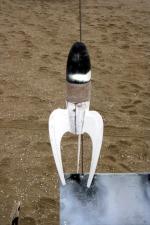
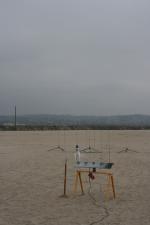
So, the moral of the story is "If at first you don’t succeed, use more impulse!" I was sure I could make the design work if I up scaled it a bit…. Or a lot! I was out of Fatboy nosecones to replace the original one with, so just repairing the original again with an up scaled motor mount was not going to be possible. However, I had a Polecat Aerospace 5.5" Fatman nosecone that I had rescued from their trash bins just sitting around collecting dust in the workshop.
The second incarnation of Blast! was built essentially the same as the original, with a few improvements. I decided to make a few compromises in the interest of getting the model done. My summer had been consumed by a large group project for Plaster Blaster and I was running out of time to make the EMRR deadline! I decided to forego the internal lug and use rail buttons. I decided to use only a single thickness for the fins. I redesigned the internal supports for the motor mount.
AutoCAD made scaling the tubing pattern up from BT-80 to 5.5" Polecat tubing. I used 3" LOC tubing for the stuffer tube on the upscale. For the motor mount, I decided to use 29mm. This should allow a high impulse G or H motor, which was my best guess at motor at the start of the second design. I decided to extend the front of the motor tube through a double wall bulkhead just behind the nosecone. This should prevent the scorching of the shock cord that I experienced on the first model and give the motor mount something substantial to push against with the much larger motor.
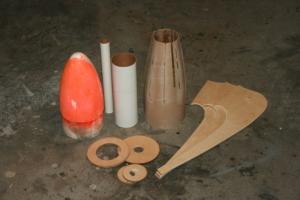
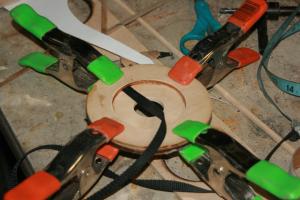
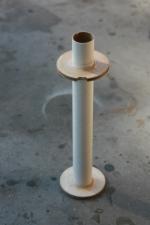
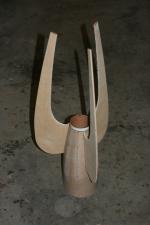
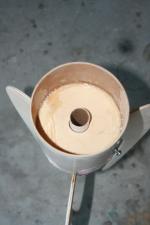
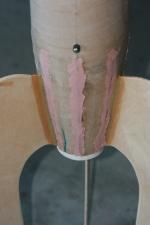
Having constructed the smaller version, Big Blast! assembled very quickly. It came together from raw materials to completed construction over the course of a weekend. Filling and finishing would take place over the next week, getting it up through primer.
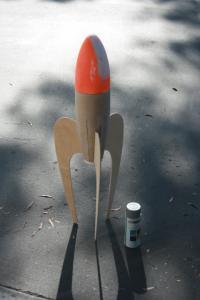
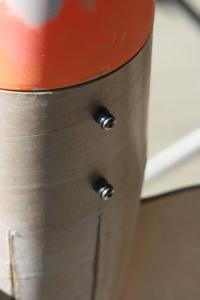
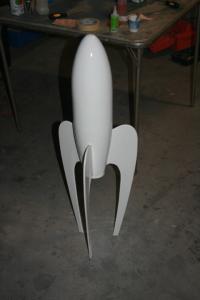
The December TRASD launch was to be the first flight of the Big Blast! (again essentially nekkid), but the launch was cancelled due to thunderstorms and the launch field turning into a mud bog. Without having a launch to go to over that weekend, I set forth on completing the finishing of the rocket. A couple of coats of red and a couple of hours of wet sanding later, it was masked and ready for the silver topcoat. The silver was sprayed and allowed to cure for a few days before the yellow was added. My handwriting is awful so my daughter did the lettering on the side of the rocket with a paint pen. After a couple of coats, I outlined the lettering with a fine tipped Sharpie marker.
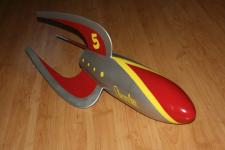
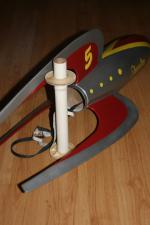
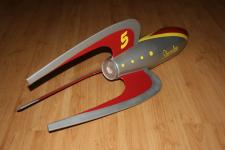
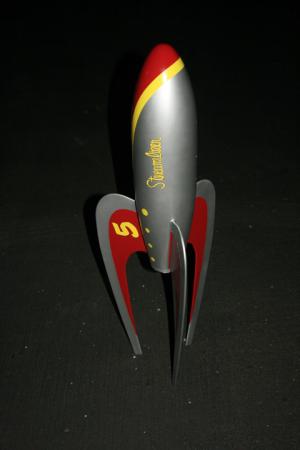 The early December DART launch was my final chance to get a launch in on the Big Blast. The rocket fully
completed came in at a dry weight of just under four pounds. Probably not a good call to attempt a G… Even a high
impulse one. I adjusted my mental plan to step up the motor to a H. Probably either a H165 Redline or a H238 Blue
Thunder. I loaded the approximate weight of the casing and reload into the tail of the rocket and did my swing test.
Not as easy as it sounds with a rocket that heavy. With the 10 ounces of nose weight I had added, it swung perfectly.
The early December DART launch was my final chance to get a launch in on the Big Blast. The rocket fully
completed came in at a dry weight of just under four pounds. Probably not a good call to attempt a G… Even a high
impulse one. I adjusted my mental plan to step up the motor to a H. Probably either a H165 Redline or a H238 Blue
Thunder. I loaded the approximate weight of the casing and reload into the tail of the rocket and did my swing test.
Not as easy as it sounds with a rocket that heavy. With the 10 ounces of nose weight I had added, it swung perfectly.
The week before the launch the weather was perfect, southern California weather. The day before, the heavens once again opened up, soaking the launch field. The night before the launch, it was scrubbed due to weather, washing away my hopes of making a contest legal flight before the deadline.
Big Blast! will fly soon and I will update the build review as soon as I have made a flight on the up scaled airframe.
I had a great time building these rockets. For a rocket with low multipliers for difficulty for the contest, I still found ways to make the builds challenging. Rear ejection, tapered tubing, finishing well beyond my normal levels, up scaled design. I really enjoy the design that CoolRockets.com has produced and now have a rocket that is a showpiece that I hope to enjoy flying for some time to come!

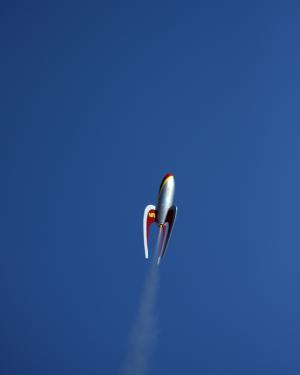
Templates:
Sponsored Ads
 |
 |











